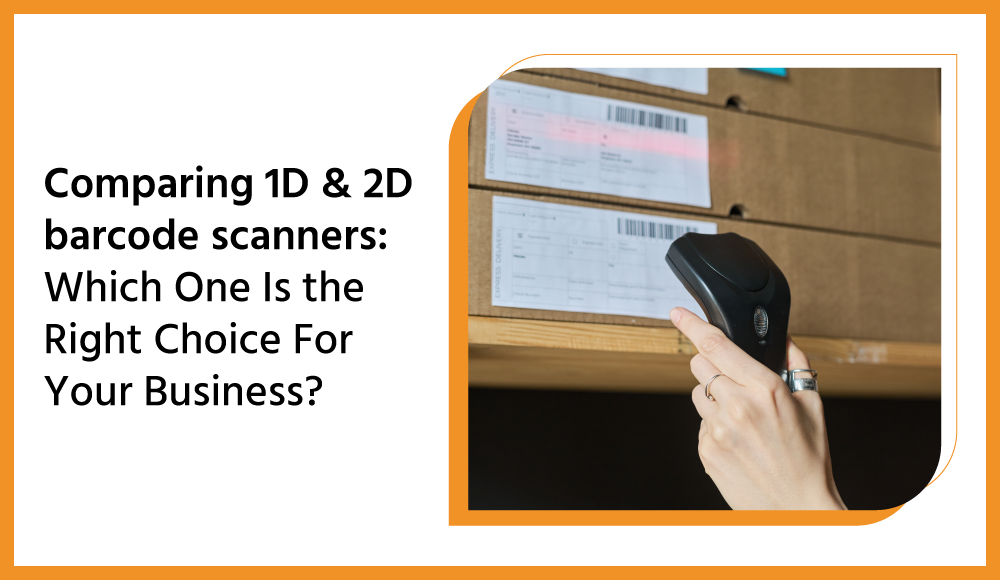
- Pixelwise Technology
- Jun 23, 2023
- Barcode Inspection
Barcodes have been a part of commerce for decades and have proven to be extremely useful for tracking, tracing, and identifying products. With the help of barcode scanners, distributors and retailers can easily access the product’s information, streamlining the process.
Due to the efficiency and versatility of barcode scanners, they are extensively used across various industries, including the retail industry, logistics and supply chain management, the healthcare sector, and manufacturing and inventory management.
1D or 2D Barcode scanners are the two extensively used scanner types. 1D scanners are employed by businesses that use linear barcodes (black and white parallel lines of varying widths). Meanwhile, 2D scanners can scan both linear and 2D codes, such as QR codes.
Understanding the unique pros and cons of 1D and 2D barcode scanning for your business is essential for choosing one that meets your needs within your budget.
Let’s begin by exploring 1D and 2D barcode scanning technologies:
Harness advanced technology with our 1D/2D barcode scanners. Boost efficiency now! Request a demo.
A] Understanding 1D Barcode Scanners
1D barcode scanners also known as linear scanners are the traditional barcode scanners that can scan 1D barcodes for product information and prices. They read the parallel black and white barcode horizontally to interpret the encoded information.
1D barcode scanners are widely adopted by businesses that favour simplicity and cost-effectiveness. 1D barcode scanners are commonly used across various industries for varying roles. They are used for:
- Quick and accurate product pricing and scanning in the retail industry.
- Accurate inventory management in logistics.
- Efficient tracking and shipping in supply-chain management.
- Identifying test samples in medical testing.
- And identifying medication for patients in the healthcare sector.
Advantages of 1D barcode scanners:
- 1D barcode scanners are inexpensive as compared to 2D scanners due to their relative simplicity.
- 1D codes use linear vertical parallel lines to store data, which makes it easier to generate and store data as compared to 2D codes.
- Because 1D codes store information in 1 direction, they are easier to scan and decode.
- 1D scanners also offer a larger scanning range and good motion tolerance.
- Streamlines data entry and reduces labour cost.
Limitations of 1D barcode scanners:
- A large amount of data can not be stored using a 1D barcode.
- Damage to the printed barcode can alter or disrupt the data stored.
B] Exploring 2D Barcode Scanners
2D barcode scanners can read 1D and 2-dimensional data such as Data Matrix or QR Code. 2D barcodes can contain a large amount of data as compared to 1D codes by storing data horizontally as well as vertically. 2D codes consist of squares, hexagons, dots, and other shapes.
2D Barcodes are versatile and can store a large amount of data efficiently. They are modern counterparts to 1D codes and are used extensively through various industries for:
- Providing detailed information about the product to e-commerce customers.
- Inventory tracking, asset management, and quality control in product manufacturing industries.
- Accurately tracking and managing medical samples and instant identification.
- Scanning and making payments in the e-commerce sector.
- Enhanced logistic tracking and reduced errors.
Advantages of 2D barcode scanning over 1D:
- 2D barcodes can store large quantities of data in a compact code by using horizontal and vertical space.
- In contrast to 1D barcodes, 2D codes can contain images, website URLs, voice data, etc.
- In case of 15 to 20% damage to the code, with the help of an error correction formula can help to retrieve the data
- You can easily scan 2D codes from any angle and direction.
Limitations of 2D barcode scanners:
- It requires specialised barcode scanning technology.
- It is costly compared to 1D scanners.
C] Key Distinctions: 1D vs 2D Barcode Scanning
1. Scanning Technology
1D barcode scanners are limited to scanning the parallel lines of the barcode in a linear barcode. 1D barcode scanners use laser or LED technology to scan the code and gather the information by measuring the reflected light intensity from the barcode lines. 2D barcode scanners use image-based technology to scan 1D and 2D codes. They use image processing techniques to decode the information from the codes. They can also scan variable 1D & 2D code prints.
2. Data Storage Capacity
1D barcodes store data with the help of black vertical lines and white spaces of varying widths. The 1D barcode scanner can only scan data from one direction, generally left to right, which means the barcode needs to be stretched to fit more data. On the other hand, 2D scanners can scan data horizontally and vertically, so 2D barcodes can store large amounts of data in a compact design. 1D barcode scanners can only scan alphanumeric data, while 2D scanners can scan images, website URLs and language data.
3. Types Of Barcodes Supported
1D barcode scanners are more traditional and can only read and scan linear barcodes. Due to a lack of versatility, they are optimal for scanning conventional codes such as code 39, code 128 and UPC. 2D scanners are more versatile and can scan both 1D and 2D barcodes, thanks to their built-in camera and image-based technology and even ensure quality in variable data printing.
4. Versatility And Flexibility
1D barcode scanners are suited for quick and easy data scanning; hence it is the best option for retailers to know about the product’s description, expiry date and price. On the other hand, 2D barcode scanners are versatile and flexible and can be used for various applications throughout various industries. 2D scanners are used in logistics, manufacturing, healthcare, e-commerce and more.
D] Choosing Between 1D And 2D Barcode Readers
Listed below are the primary factors that can help you decide which barcode scanning method is right for you: 1D or 2D?
1. Industry-specific requirements
While choosing a barcode reader, you should take your specific industry requirements into account. 1D barcodes are reliable for quick and easy product identification and inventory management, while 2D barcodes offer greater flexibility. In addition, 2D scanners are also great for barcode verification.
2. Scanning volume and speed
Consider the volume and speed of barcode scanning required by your business on a daily basis before investing in a scanner. If your business requires a high volume of barcodes at an express speed, 2D barcode scanners might be the correct choice. 2D scanners use modern technology to provide efficient and accurate scanning.
3. Cost considerations
Finding the right scanner for your business also means finding one that fits your budget. 1D scanners are usually more affordable than 2D scanners due to their simplicity. However, you must also consider the ROI when investing in a scanner. Consider if your business can gain more revenue by investing in an expensive scanner, and if it is worth the investment in the long term.
4. Future scalability and adaptability
While selecting a barcode scanner, factor in your business’s growth and future needs. 2D scanners offer more scalability and adaptability as they are useful for both 1D and 2D barcodes.
Harness advanced technology with our 1D/2D barcode scanners. Boost efficiency now! Request a demo.
Conclusion
Barcode scanners can be crucial for streamlining the process and increasing the efficiency of scanning, tracking and retrieving product information. While selecting a barcode scanner for your business needs, it is crucial to compare them both, look at their pros and cons, avoid the top barcode mistakes and consider your unique business needs.
A high-quality barcode scanner is a good investment for the business. If you are looking for a barcode scanner, we are here to help you find the correct 1D and 2D barcode scanner for your business’s needs within your budget. Contact us today!





